New Science
-
Smallest Extrasolar Planet Found
2005-02-19 Astronomers from Penn State and Caltech have found the smallest extrasolar planet yet, orbiting a pulsar 1,500 light-years away. The small planet - the fourth discovered around this pulsar - has 1/5th the mass of Pluto, and orbits approximately the same distance as the asteroid belt orbits the Sun.
Astronomers from Penn State and Caltech have found the smallest extrasolar planet yet, orbiting a pulsar 1,500 light-years away. The small planet - the fourth discovered around this pulsar - has 1/5th the mass of Pluto, and orbits approximately the same distance as the asteroid belt orbits the Sun. -
A Big Rip, But Not the End of the World
2005-02-12 Scientists in Spain have proposed, after years of research, that in 22 billion years, the universe will be torn to pieces in a so-called "Big Rip," as a result of the ongoing expansion of the universe. However, the Big Rip does not necessary bring the world to its very end. This is in sharp contrast to the suggestion brought out by an American scientist in early 2003, that the Big Rip is tantamount to the end of the world.
Scientists in Spain have proposed, after years of research, that in 22 billion years, the universe will be torn to pieces in a so-called "Big Rip," as a result of the ongoing expansion of the universe. However, the Big Rip does not necessary bring the world to its very end. This is in sharp contrast to the suggestion brought out by an American scientist in early 2003, that the Big Rip is tantamount to the end of the world. -
Discovery of New "Arm" Requires Map of Milky Way to be Redrawn
2005-02-11 A New Scientist article on May 9th, 2004, reported that astronomers, "made their discovery while mapping the distribution of hydrogen gas within the Milky Way... The structure consists of an arc of hydrogen gas 77,000 light years long and a few thousand light years thick running along the galaxy's outermost edge," and that it "sweeps around outside the other arms."
A New Scientist article on May 9th, 2004, reported that astronomers, "made their discovery while mapping the distribution of hydrogen gas within the Milky Way... The structure consists of an arc of hydrogen gas 77,000 light years long and a few thousand light years thick running along the galaxy's outermost edge," and that it "sweeps around outside the other arms." -
New Star! A Halo Expanding a Thousand Times Faster Than the Speed of Light
2005-02-09 We all know that expansion cannot be unlimited. Explosion will occur at a certain level of expansion. It is easy to see how balloons and tires expand and then explode. However, it isn't easy to discover expansion of a ring in the universe. Astronomers made a wonderful finding that news stars form after expanding rings explode.
We all know that expansion cannot be unlimited. Explosion will occur at a certain level of expansion. It is easy to see how balloons and tires expand and then explode. However, it isn't easy to discover expansion of a ring in the universe. Astronomers made a wonderful finding that news stars form after expanding rings explode. -
Epoch Times: Recent Discoveries Raise New Theories on the Origin of Life
2005-02-05 Scientists have been tracking the transformations of new galaxies. In late 2004, the U.S. National Aeronautics and Space Administration announced that amidst the ancient galaxies surrounding our Milky Way, dozens of infant galaxies are emerging. These galaxies are about 1 billion light years away from us, but they are 9 billion light years closer to us than any other galaxies. Researchers are thrilled by this observation, since the birth of galaxies was thought to happen only billions of years ago.
Scientists have been tracking the transformations of new galaxies. In late 2004, the U.S. National Aeronautics and Space Administration announced that amidst the ancient galaxies surrounding our Milky Way, dozens of infant galaxies are emerging. These galaxies are about 1 billion light years away from us, but they are 9 billion light years closer to us than any other galaxies. Researchers are thrilled by this observation, since the birth of galaxies was thought to happen only billions of years ago. -
ET Visitors: Scientists See High Likelihood
2005-01-24 Decades ago, it was physicist Enrico Fermi who pondered the issue of extraterrestrial civilisations with fellow theorists over lunch, generating the famous quip: "Where are they?" That question later became central to debates about the cosmological census count of other star folk and possible extraterrestrial (ET) visitors from afar.
Decades ago, it was physicist Enrico Fermi who pondered the issue of extraterrestrial civilisations with fellow theorists over lunch, generating the famous quip: "Where are they?" That question later became central to debates about the cosmological census count of other star folk and possible extraterrestrial (ET) visitors from afar. -
In Search of Hidden Dimensions
2005-01-19 String theory emerged in the 1980s as a way to answer questions that still baffle modern physics, such as why gravity is so much weaker than other fundamental forces? By imagining that everything is composed entirely of strings ten billion billion times smaller than atomic nuclei, theoretical physicists were able to create a model of the universe.
String theory emerged in the 1980s as a way to answer questions that still baffle modern physics, such as why gravity is so much weaker than other fundamental forces? By imagining that everything is composed entirely of strings ten billion billion times smaller than atomic nuclei, theoretical physicists were able to create a model of the universe. -
The Faintest Spectra Ever Raise a Glaring Question: Why do Galaxies in the Young Universe Appear So Mature?
2005-01-18 These galaxies appear to be more fully formed and mature than expected at this early stage in the evolution of the Universe. This finding is similar to a teacher walking into a classroom expecting to greet a room full of unruly teenagers and finding well-groomed young adults.
These galaxies appear to be more fully formed and mature than expected at this early stage in the evolution of the Universe. This finding is similar to a teacher walking into a classroom expecting to greet a room full of unruly teenagers and finding well-groomed young adults. -
Hubble Photographs Warped Galaxy as Camera Passes Milestone
2005-01-17 The strong warping of the disk indicates that ESO 510-G13 has recently undergone a collision with a nearby galaxy and is in the process of swallowing it. Gravitational forces distort the structures of the galaxies as their stars, gas, and dust merge together in a process that takes millions of years. Eventually the disturbances will die out, and ESO 510-G13 will become a normal-appearing single galaxy.
The strong warping of the disk indicates that ESO 510-G13 has recently undergone a collision with a nearby galaxy and is in the process of swallowing it. Gravitational forces distort the structures of the galaxies as their stars, gas, and dust merge together in a process that takes millions of years. Eventually the disturbances will die out, and ESO 510-G13 will become a normal-appearing single galaxy. -
A Galaxy's Fatal Plunge
2005-01-16 Astronomers are using a wide range of telescopes and analysis techniques to conduct a "CSI" or Crime Scene Investigator-style look at what is happening to this galaxy inside its cluster's rough neighbourhood. "It's a clear case of galaxy assault and battery," says William Keel of the University of Alabama. "This is the first time we have a full suite of results from such disparate techniques showing the crime being committed, and the modus operandi."
Astronomers are using a wide range of telescopes and analysis techniques to conduct a "CSI" or Crime Scene Investigator-style look at what is happening to this galaxy inside its cluster's rough neighbourhood. "It's a clear case of galaxy assault and battery," says William Keel of the University of Alabama. "This is the first time we have a full suite of results from such disparate techniques showing the crime being committed, and the modus operandi." -
Scientists Say Our Milky Way is Getting Lonelier
2004-12-14 In February of 2004, the National Aeronautics and Space Administration (NASA) issued an announcement that dark energy indeed exists. According to observation, nearly all galaxies in the universe are receding from our galaxy at an ever-increasing pace. Astronomers think, based on the present understanding, our galaxy will become lonelier.
In February of 2004, the National Aeronautics and Space Administration (NASA) issued an announcement that dark energy indeed exists. According to observation, nearly all galaxies in the universe are receding from our galaxy at an ever-increasing pace. Astronomers think, based on the present understanding, our galaxy will become lonelier. -
Atoms of Ancient Chinese Pigment Condense to Form Giant “Matter Wave”
2004-11-29 Chinese chemists synthesised Han Purple pigment from barium copper silicates for the first time roughly 2,000 years ago and used the pigments for pottery and trade, in addition to large imperial projects such as the Qin Terracotta Warriors of Xi'an in Shaanxi Province. Preceding the invention of both paper and the compass, the ancient creation of Han Purple possibly makes it the first man-made compound containing a metallic bond.
Chinese chemists synthesised Han Purple pigment from barium copper silicates for the first time roughly 2,000 years ago and used the pigments for pottery and trade, in addition to large imperial projects such as the Qin Terracotta Warriors of Xi'an in Shaanxi Province. Preceding the invention of both paper and the compass, the ancient creation of Han Purple possibly makes it the first man-made compound containing a metallic bond. -
Clues to the Births of Stars and Planets
2004-11-17 In one discovery, astronomers have detected a faint, star-like object in the least expected of places -- a "starless core." Named for their apparent lack of stars, starless cores are dense knots of gas and dust that should eventually form individual newborn stars.
In one discovery, astronomers have detected a faint, star-like object in the least expected of places -- a "starless core." Named for their apparent lack of stars, starless cores are dense knots of gas and dust that should eventually form individual newborn stars. -
Massive Merger of Galaxies Is the Most Powerful On Record
2004-10-09 An international team of scientists, led by a NASA-funded researcher, announced today, they observed a nearby head-on collision of two galaxy clusters. The clusters smashed together thousands of galaxies and trillions of stars. It is one of the most powerful events ever witnessed. Such collisions are second only to the Big Bang in total energy output.
An international team of scientists, led by a NASA-funded researcher, announced today, they observed a nearby head-on collision of two galaxy clusters. The clusters smashed together thousands of galaxies and trillions of stars. It is one of the most powerful events ever witnessed. Such collisions are second only to the Big Bang in total energy output. -
Scientists Discover Two Extremely Hot Extra-Solar Planets
2004-07-13 During the past ten years, astronomers have confirmed that the Solar System is not unique because they have now discovered over 120 giant planets orbiting other stars. It is a rare discovery to find new planets, not to mention giant planets that orbit extremely close to their parent stars. Astronomers have not been able to explain this strange phenomenon.
During the past ten years, astronomers have confirmed that the Solar System is not unique because they have now discovered over 120 giant planets orbiting other stars. It is a rare discovery to find new planets, not to mention giant planets that orbit extremely close to their parent stars. Astronomers have not been able to explain this strange phenomenon.



 more ...
more ...